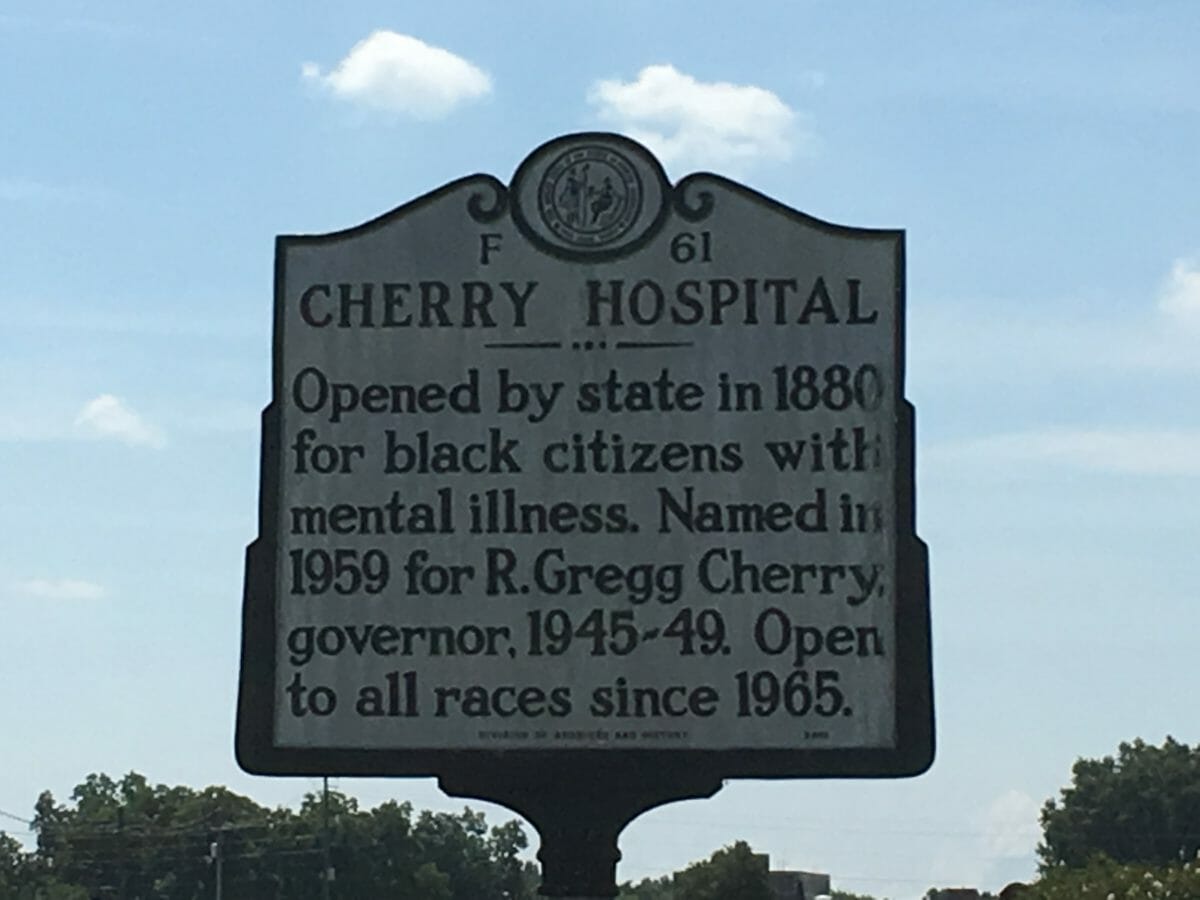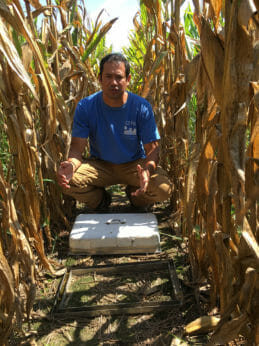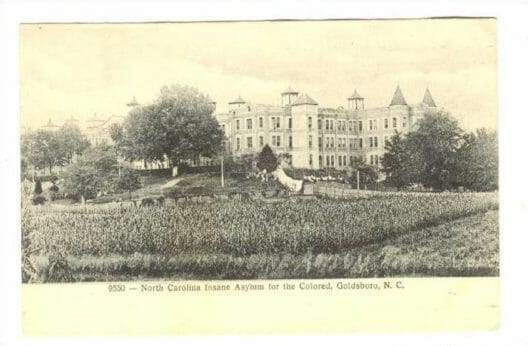The Strange, Horrifying History of Cherry Research Farm in North Carolina
A farm in North Carolina is the site of cutting-edge animal agriculture research – and a few ghosts.
The Strange, Horrifying History of Cherry Research Farm in North Carolina
A farm in North Carolina is the site of cutting-edge animal agriculture research – and a few ghosts.

Moreno, a soft-spoken Panamanian man, is part of a team of researchers at Cherry Farm, a 2,200-acre facility about an hour outside of Raleigh that is jointly operated by the North Carolina Department of Agriculture and the Center for Environmental Farming Systems at North Carolina State University. It is one of the largest and most important sites in the country for long-term sustainable agriculture research. Among dozens of other projects, Moreno and his colleagues have been comparing emissions from six different cropping systems in hopes of developing cultivation techniques with a lower carbon footprint.

Following the cables that snake from an air-conditioned trailer at the edge of the corn field, in which an array of sensitive scientific equipment is housed, we approach a tiny plastic dome over the soil where air samples are collected for analysis. We nearly run headfirst into an enormous and sinister-looking spider stretched out on a web between the fading stalks. The hair on my neck suddenly stands on end – and not for the first time in the hour since I arrived.
Cherry Farm, sandwiched between a state penitentiary and a rehab center for paroled drug offenders, strikes me as a desolate spot to conduct sustainable agriculture research. I joke with Moreno that it must be a spooky place to work. I’d be paranoid about who might be lurking in the bushes every time the wind rustles the leaves. He replies that there is more to the story of Cherry Farm than the occasional threat of escaped jailbirds. “You must have heard,” he says, trailing off, his eyes darting about a bit furtively. “Cherry Farm has a strange history.”
For nearly a century, Cherry Farm served a very different purpose: it formed the grounds of Cherry Hospital, a notorious mental institution founded in 1890 as North Carolina’s “Asylum for Colored Insane,” as a historical placard informs me as I leave Moreno to putter through what amounts to a small village of dilapidated buildings on one side of the farm. It was the sole mental institution for African-Americans in the state until the Civil Rights Act came along in 1964 and forced Cherry Hospital (it had been renamed for the former governor R. Gregg Cherry in 1959) to desegregate and start admitting white patients.
While it looks to me like a ghost town – the austere red-brick buildings, many of them with busted windows and weeds growing from the roof, appear long-abandoned – Cherry Hospital operated at the site until last year, when the residents were moved to a new facility up the road. The fields where Moreno now works produced food for the residents of Cherry Hospital, many of whom worked the land as part of their therapy, and generated income for the institution until 1974, when the NC Department of Agriculture assumed ownership of the farm.
An 1884 report from the asylum’s superintendent bragged about the productivity of what was then a 171-acre enterprise: “80 barrels corn, 6,000 pounds of fodder, 50 bushels of peas, and 3,000 pounds of oats. We now have 37 hogs for butchering and estimate their weight at 4,000 pounds. An accurate account of the vegetables has not been kept, and the value of our kitchen garden can hardly be estimated. The orchard again gave us apples in abundance.”
The farm was expanded as the population of Cherry Hospital grew to over 3,000 individuals. While horticultural therapy would now be considered a progressive form of treatment for mental illness, it’s not clear how therapeutic it actually was for a population only recently removed from slavery – picking cotton was one of the residents’ farm duties, for example. Other forms of “treatment” used at Cherry Hospital – including electroshock therapy and locking troublesome patients in cages (a practice that was not abandoned until 1956) – certainly were not.
Ideas about mental health at the turn of the 20th century were almost as archaic as the attitude toward civil rights at the time. The 1884 superintendent’s report listed “causes of insanity” for the patients that seem absurd in modern times, such as masturbation and “deranged menses.” While conditions were described as crowded, the superintendent saw no need to do anything about it, lest resources be diverted from the white asylums of the state: “It is not… recommend here that steps should be taken for enlarging. The State, at present, has a large burden in providing for the white insane.”
Local rumors that the place is haunted may stem in part from the two cemeteries at the site, where deceased residents of Cherry Hospital were routinely buried without a proper funeral. Hundreds of graves are marked solely with a number that corresponds to the person’s I.D. at the institution, while thousands more unmarked graves were identified in a 2002 archeological study. A local author is currently researching a book on the stories of paranormal activity that have accrued over the years.
To some extent, it seems that the decrepit conditions at Cherry Hospital have extended into modern times. In 2008, the hospital’s federal funding was nearly revoked following the death of a resident under suspicious circumstances. According to news reports, the person, who was suffering from a medical condition, died after being left unattended with nothing to eat for several days. A security camera revealed that negligent hospital staff were “watching TV and playing cards a few feet away” as the patient succumbed to their illness.
One of Cherry Hospital’s most horrifying cases came to a close in 2001 with the death of 93-year old Junius Wilson, a deaf man who had been a resident since he was 17. Wilson was accused of attempted rape in 1925; assumed to be insane because he communicated only in grunts and strange hand gestures, he was locked up at the Asylum for the Colored Insane. The cooked-up rape accusation was finally dropped in the 1970s, but it wasn’t until 1991 that a social worker realized Wilson was not mentally ill, but merely deaf – he used a unique form of sign language taught to African-Americans in the South historically, which had apparently been misinterpreted as the wild gesturing of a crazy person.

Not only was Wilson falsely accused, and essentially left to rot among mentally unstable people for seven decades, he was castrated by Cherry Hospital staff upon admittance – a not uncommon fate for people of color accused of rape at the time.
Wilson’s story made national news when it broke in the early nineties, and a book about his life, [amazon_textlink asin=’0807831557′ text=’Unspeakable’ template=’ProductLink’ store=’modefarm-20′ marketplace=’US’ link_id=’c07be44f-df72-11e7-8088-1b4040c1d219′], was published in 2007, which doubled as something of an exposé of the egregious conditions suffered by many other men and women at Cherry Hospital over the years.
After being freed from confinement, Wilson, who had no known living family members, was given a small cottage of his own on the grounds of the hospital. He had a yellow bike that he rode around the farm in his later years, and was often seen fishing at the river that ran behind the fields or tending to the dogs that he kept in one of the barns. Despite the horrors of his life, apparently he died in peace. So perhaps there is at least one benevolent ghost lurking in the cornfields here, as Cherry Farm transforms its heinous past into a brighter future.
SaveSave
SaveSave
Follow us
This work is licensed under a Creative Commons Attribution-NoDerivatives 4.0 International License.
Want to republish a Modern Farmer story?
We are happy for Modern Farmer stories to be shared, and encourage you to republish our articles for your audience. When doing so, we ask that you follow these guidelines:
Please credit us and our writers
For the author byline, please use “Author Name, Modern Farmer.” At the top of our stories, if on the web, please include this text and link: “This story was originally published by Modern Farmer.”
Please make sure to include a link back to either our home page or the article URL.
At the bottom of the story, please include the following text:
“Modern Farmer is a nonprofit initiative dedicated to raising awareness and catalyzing action at the intersection of food, agriculture, and society. Read more at <link>Modern Farmer</link>.”
Use our widget
We’d like to be able to track our stories, so we ask that if you republish our content, you do so using our widget (located on the left hand side of the article). The HTML code has a built-in tracker that tells us the data and domain where the story was published, as well as view counts.
Check the image requirements
It’s your responsibility to confirm you're licensed to republish images in our articles. Some images, such as those from commercial providers, don't allow their images to be republished without permission or payment. Copyright terms are generally listed in the image caption and attribution. You are welcome to omit our images or substitute with your own. Charts and interactive graphics follow the same rules.
Don’t change too much. Or, ask us first.
Articles must be republished in their entirety. It’s okay to change references to time (“today” to “yesterday”) or location (“Iowa City, IA” to “here”). But please keep everything else the same.
If you feel strongly that a more material edit needs to be made, get in touch with us at [email protected]. We’re happy to discuss it with the original author, but we must have prior approval for changes before publication.
Special cases
Extracts. You may run the first few lines or paragraphs of the article and then say: “Read the full article at Modern Farmer” with a link back to the original article.
Quotes. You may quote authors provided you include a link back to the article URL.
Translations. These require writer approval. To inquire about translation of a Modern Farmer article, contact us at [email protected]
Signed consent / copyright release forms. These are not required, provided you are following these guidelines.
Print. Articles can be republished in print under these same rules, with the exception that you do not need to include the links.
Tag us
When sharing the story on social media, please tag us using the following: - Twitter (@ModFarm) - Facebook (@ModernFarmerMedia) - Instagram (@modfarm)
Use our content respectfully
Modern Farmer is a nonprofit and as such we share our content for free and in good faith in order to reach new audiences. Respectfully,
No selling ads against our stories. It’s okay to put our stories on pages with ads.
Don’t republish our material wholesale, or automatically; you need to select stories to be republished individually.
You have no rights to sell, license, syndicate, or otherwise represent yourself as the authorized owner of our material to any third parties. This means that you cannot actively publish or submit our work for syndication to third party platforms or apps like Apple News or Google News. We understand that publishers cannot fully control when certain third parties automatically summarize or crawl content from publishers’ own sites.
Keep in touch
We want to hear from you if you love Modern Farmer content, have a collaboration idea, or anything else to share. As a nonprofit outlet, we work in service of our community and are always open to comments, feedback, and ideas. Contact us at [email protected].by Brian Barth, Modern Farmer
December 11, 2017
Modern Farmer Weekly
Solutions Hub
Innovations, ideas and inspiration. Actionable solutions for a resilient food system.
ExploreExplore other topics
Share With Us
We want to hear from Modern Farmer readers who have thoughtful commentary, actionable solutions, or helpful ideas to share.
SubmitNecessary cookies are absolutely essential for the website to function properly. This category only includes cookies that ensures basic functionalities and security features of the website. These cookies do not store any personal information.
Any cookies that may not be particularly necessary for the website to function and are used specifically to collect user personal data via analytics, ads, other embedded contents are termed as non-necessary cookies.
Hidden history. The name should be changed to “Junius Wilson” Hospital For The MENTALLY ill. Unbelievable, the justice system has been corrupt and unfair to African Americans for decades. He’s definitely not the 1st and not the last.
I worked there for about 3 years. Reffering to the previous comment, I have heard tales of the woman in the window of an abandoned building. I never witnessed anything while working there, but plenty of times I have heard doors closing and opening from the empty floor above my assigned unit. And unexplained voices coming from stairwells within the building and the ones on the outside.
Dr. Brown discovered that Junious Wilson was not only deaf but was mute. This very nice old fellow was affecitonatly called “Dummy”. Dr. Brown wanted to pay, himself, to have him treated and fitted with a hearing aid but it was thought, at the time, that it might actually be a detriment to him. He could only make sounds. He was harmless.
I worked there during this time and had discussions, with Dr. Brown, about this.
It was not in 1991 that a social worker discovered this.
This man who was deaf mute used to help my father around the house. Unceremoniously called “dummy”. He was always kind and polite to us as kids, mom and dad. My father treated him like the kind man he was and with respect. None of us kids were afraid of him. He would smile and grunt when we said hello to him. Yes we heard those stories about rape and castration. It was just not a story we put stock in. I am glad to hear an update, albeit heartbreaking. Thanks for sharing this story of employees kids who lived… Read more »
I would like to be able to contact someone to have my group do an investigation there. I am presuming that it is closed and no one is there anymore.
Additional info about Cherry Hospital. The government did experiments on stage 3 siphilus (spelling) patients. I was one of the 7 people who got malaria from the mosquitoes that escaped from the experiment. We lived in the employees housing. The superintendent of the hospital was a Jewish dr who survived WW2. I was angry for years until I learned it was not his idea or plans… and that experiment was also done at other hospitals.
i have seen what look like a woman looking out one of the abandoned buildings i would park beside this was at the old cherry. a nurse told me while she worked there she saw a patient walk out of one room unto another room the nurse went to investigate and everyone was asleep.
That is really mysterious. Thanks for sharing this blog. i find it very interesting.
How could one go about doing a Paranormal investigation at this place? Anyone know.
Mr. Wilson’s death in 2001 led to my freedom. I’m forever thankful. I will one day write my journey with him in it. For now, I must keep surviving my emotional past til I can sit still to write.